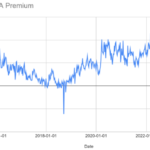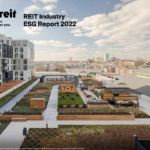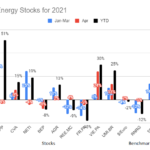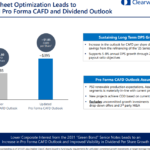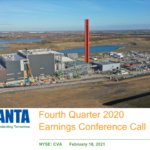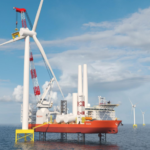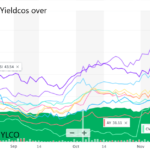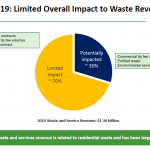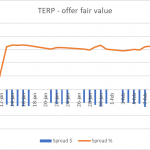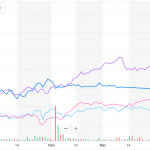The Clear Way to Buy Clearway
By Tom Konrad, Ph.D., CFA
A reader of my recent article on Yieldcos asked which share class of Clearway Energy was the better to buy for tax purposes: Class A shares (CWEN-A) or Class C Shares (CWEN).
For tax purposes, they are identical. They pay the same dividend, and it is treated the same no matter which share class you buy. The reason many large investors often trade CWEN rather than CWEN-A is because it is more liquid. As I write on Jan 23rd, Yahoo! Finance puts the 3 month average share volume for CWEN at 1,372,714, while the corresponding number...
Yieldco Valuations Look Attractive
By Tom Konrad Ph.D., CFA
Despite a run-up in the fourth quarter of 2023, it has been a long time since valuations of clean energy stocks have been this cheap. Perhaps it is worries about hostility towards clean energy under a new Trump administration, or disappointment at the slow implementation of the Inflation Reduction Act. Whatever the cause, prices are low, and many clean energy stocks are likely to produce good returns even if the political climate turns further against them.
This is especially true for companies that are less dependent on favorable policy or subsidies. For instance, Yieldcos, high...
Five Green REITs
by Tom Konrad Ph.D., CFA
Why Green Buildings are Profitable Buildings
Buildings are responsible for approximately a third of greenhouse gas emissions, so making buildings more efficient and switching them to renewable sources of energy is an essential part in addressing climate change.
Fortunately, new technologies such as cold climate heat pumps, heat pump water heaters, induction stoves, as well as the ever falling cost of renewable electricity and improvements to insulation and building envelopes often provide opportunities to improve buildings while achieving extremely attractive investment returns from the energy and maintenance savings alone.
Because of the great financial returns, building owners who...
Buying Innergex – Texas Was Bad, But Not That Bad
By Tom Konrad, Ph.D., CFA
Last week, I published this call to buy Innergex (INGXF, INE.TO) because investors had been overreacting to the losses from the February cold snap in Texas. The stock is up since then, but still seems a decent value.
Canadian Yieldco Innergex Renewable Energy (INGXF, INE.TO) took a big financial hit from the power disruptions in Texas in March.
It's complex, but their financial hedges on power prices for three of its wind farms ended up creating enormous liabilities - more, in fact, than two of their wind farms are worth. Two of their facilities also had benefits...
Atlantica Q1, Buying Hannon Armstrong
By Tom Konrad, Ph.D., CFA
Here are two more updates from last week on Patreon. Also, I realize I neglected to publish the monthly performance chart for my 10 Clean Energy Stocks model portfolio here at the start of the month, so here it is as well:
Atlantica Sustainable Infrastructure Earnings
(published May 11th)
Atlantica Sustainable Infrastructure (AY) released its first quarter earnings announcement and financial statements on May 6th.
Atlantica is one of the higher yielding Yieldcos, 5.3% at the new quarterly dividend rate of $0.43 and a $32.50 stock price. The dividend is safe, since most of Atlantica's debt is fixed rate,...
Q1 Earnings Roundup: Yieldcos (AGR, BEP, CWEN, GPP)
By Tom Konrad, Ph.D., CFA
This is a roundup of first quarter earnings notes shared with my Patreon supporters over the last week. If there is any theme, it’s that low interest rates and increased interest in green investments is lowering Yieldcos’ cost of capital to the benefit of stock investors.
Avangrid Earnings
Avangrid's (AGR) Q1 earnings report showed solid progress. Key items of note were:
Increased outlook for full year 2021 Adjusted EPS a little over 5%
Key environmental approval for 800 MW offshore wind farm Vineyard Wind. Expected to begin construction later this year, with expected completion in 2024. Avangrid...
Covanta and Hannon Armstrong Earnings
by Tom Konrad, Ph.D. CFA
Two more earnings notes I shared with my Patreon followers on February 18th.
Covanta Holdings (CVA)
Leading waste-to-energy firm Covanta Holdings (CVA) announced 2020 earnings today. There will be a conference call tomorrow morning, but here is my high-level impression:
The company managed well through Covid and ended the year within it's original pre-covid guidance. Metals and energy prices, as well as increased maintenance capital expenditures were a drag on results, but prices are improving and capital expenditures will fall in 2021.
The company is conducting a strategic review which will likely result in the sale of some underperforming...
Eneti and Brookfield Renewable Earnings
By Tom Konrad, Ph.D. CFA
Here are a couple earnings notes I shared last week with my Patreon followers.
Eneti, Inc. (NETI) - formerly Scorpio Bulkers (SALT)
Eneti completed its name and ticker change on February 8th. New ticker is NETI (formerly Scorpio Bulkers (SALT), which I recently wrote about here.
Highlights from February 2nd earnings report:
37 of the 47 vessels owned at the 3rd quarter have been sold or have completed sale agreements.
Net asset value is $23.94/share. Since most assets are cash or vessels held for sale, this number is basically accurate.
The stock is still a good buy...
The Yieldco Virtuous Cycle
by Tom Konrad, Ph.D., CFA
Readers who followed my coverage of the Yieldco bubble in 2015 know the Yieldco Virtuous Cycle.
A Yieldco’s stock price rises
It issues new shares, and invests the money in renewable energy projects.
Because the stock price is high, it is able to buy more project cash flow by issuing fewer shares than it has in the past.
Cash flow available for distribution (CAFD) per share increases, despite the increasing number of shares outstanding.
Yieldco management sets a target for continued rapid annual distribution growth, which can be met either by further share issuance (if...
Funding The Energy Transition at Clean Energy Credit Union
by Tom Konrad, Ph.D., CFA
With interest rates as low as they have ever been, I believe there is little point in small investors investing in bonds or bond funds, even if an allocation to fixed income is needed to match their investments to their ability and desire to take on risk. With little potential upside from interest, I believe it is better to take advantage of the added safety of federally backed insurance by depositing money in a bank or credit union savings account or certificate of deposit (CD) ladder.
We can do that and avoid having our deposits fund...
Royalties: a Financial Innovation for Renewable Energy
The following interview with RE Royalties (RE.V, RROYF) CEO Bernard Tan was conducted in September by AltEnergyStocks.com Editor Tom Konrad. Links and ticker symbols were not included in his original responses, but added by AltEnergyStocks.com as a resource for readers.
Q: What exactly is a renewable energy royalty?
A renewable energy royalty is a stream of cash flows generated by a renewable energy project. When the project generates electricity and sells its electricity, we receive a percentage of the revenues from the electricity sales, otherwise known as a gross revenue royalty. We receive that gross revenue royalty, on average, for about...
Buyer’s Guide to New York Community Solar
By Ishaan Goel
WHY COMMUNITY SOLAR?
A home solar system is a great investment, with financial returns far in excess of any financial investment that has comparable risk. It’s also a tangible step a homeowner can take to help the environment.
Unfortunately, most New Yorkers (and Americans in general) can’t install home solar. They may be renters, or have roofs that are too old or shaded. Or they may not be able to afford the up-front cost, or not have enough income to take advantage of the tax credits.
That is why New York’s electricity regulator, the Public Service Commission, created community solar:...
10 Clean Energy Stocks for 2020: Updates on GPP, HASI, CVA
by Tom Konrad, Ph.D., CFA
Market Decline
Last week I warned "The risks in today's stock market outweigh the possibility of future potential gains." Looks like we're seeing those risks manifest in short order. The last couple days' decline have me looking at a few stocks to start adding to my positions again, especially MiX Telematics (MIXT) discussed on June 2nd and Green Plain Partners (GPP), discussed below.
Note that this pullback could easily be very early days of a much larger market decline. We might even see the market fall far enough to test the March lows... any of my buying...
Why is Terraform Power Trading at a Premium to the Brookfield Renewable Merger Value?
Tom Konrad, Ph.D., CFA
A reader asked:
Read your recent article on Pattern Energy (PEGI). Great summary and thoughts.
Would like to ask your view on TERP potential takeover by BEP (via shares swap) and whether you reckon the recent run-up on TERP is too excessive?
It's a good question, and one that Robbert Manders on Seeking Alpha did a thorough analysis of here. For the details of the merger, I refer you to his work.
While his analysis is careful and complete, I disagree with his conclusion. TERP shares are not trading at a significant premium to the merger value. The reason is...
Should Pattern Energy Shareholders Vote Against the Merger?
by Tom Konrad Ph.D., CFA
This morning, hedge fund Water Island Capital called on Pattern Energy (PEGI) Shareholders to vote against the merger with the Canada Pension Plan Investment Board (CPPIB).
Water Island claims the merger is undervalued compared to the recently surging prices of other Yieldcos, and that PEGI would be trading at over $30 given current valuations. There are not a lot of other Yieldcos left, especially if we eliminate those with their own special circumstances. These are Terraform Power (TERP) which is subject to its own buyout agreement with Brookfield Renewable Energy (BEP), and Clearway (CWEN and CWEN/A) where...
Green swan, Black swan: No matter as long as it reduces stranded spending
by Prashant Vaze, The Climate bonds Initiative
In January, authors from several institutions under the aegis of BiS, published The Green Swan Central banking and financial stability in the age of climate change setting out their take on the epistemological foundations for, and obstacles against, central banks acting to mitigate climate change risk.
The book’s early chapters provide a cogent and up-to-date analysis of climate change’s profound and irreversible impacts on ecosystems and society. The authors are critical of overly simplistic solutions such as relying on just carbon taxes. They also recognize the all-too-evident deficits in global policy to respond to the threat.
In short, they accept the need for central banks to act.
The Two Arguments
The paper makes two powerful arguments setting out the challenges central banks face using their usual mode of working.
Firstly, climate change’s impact on financial systems is an unknowable unknown – a...

